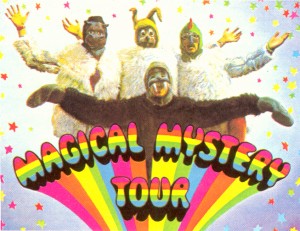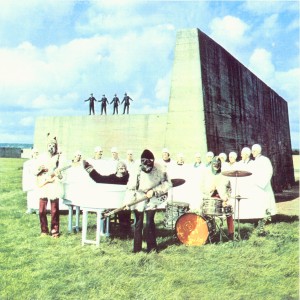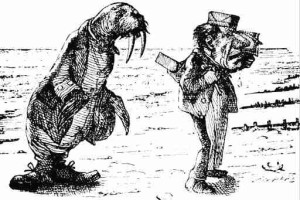"I Am the Walrus" is on the Beatles' 1967 release Magical Mystery Tour. To look for clues in "I Am the Walrus" is rather ironic, since, according to Pete Shotton, John intended to write a song with nonsensical imagery to confound those who looked for significance in every Beatle lyric. After recalling a grotesque song they used to sing as children, John strung together the most ludicrous imagery he could think of. Shotton recalls that after writing the song, "He turned to me, smiling. 'Let the fuckers work that one out, Pete.'"
Still, this hasn't stopped people from looking for "Paul is dead" clues in the song.
According to the "Paul is dead" rumor, Paul left the recording studio in anger on a "stupid bloody Tuesday" after squabbling with his bandmates.
The refrain "I'm crying" is John expressing his grief over Paul's death. The references to "pretty little policement" and "waiting for the van to come" supposedly refer to the police who were present at the site of Paul's fatal accident.
The opening line of the song, "I am he as you are he as you are me and we are all together" suggests that all of the Beatles were involved in the conspiracy.
In the "Paul is dead" mythology, the walrus is an image of death. This has been repeated so often in "Paul is dead" sources that it is taken as given, but what is the origin of this? Perhaps it started with Fred LaBour's article in The Michigan Daily or perhaps because the walrus costume on the cover of Magical Mystery Tour is the only one that is black.

Yet, a number of sources have tried to identify the cultural origins of the walrus as image of death. The Book of Rock Lists chose the path of least resistance and stated simply that "In some societies, the walrus is an image of death".
And John Neary, who wrote the Life article, was just as vague when he stated that the "black walrus [is] a folk symbol of death."
B.J. Phillips of the Washington Post, however, took a stab at ascribing the cultural origins of the walrus-as-symbol-of-death when he reported that "According to the hypothesis, the walrus is a symbol of death, although its origins have been attributed to such dissimilar sources as the ancient Greeks and modern Eskimos."
In his tongue-in-cheek piece, Fred LaBour asserted that "'Walrus' is Greek for corpse."
As Barbara Suczek pointed out, however, the word "walrus" is of Scandinavian origin.
Perhaps that's where the Chicago Sun-Times came up with "The walrus is supposed to be the Viking symbol of death"
, but the closest any "Paul is dead" source has come to supporting that claim was when Andru J. Reeve quoted a Michigan student who reported that "a guy in my folklore class told me that when Nordic Vikings started off on a journey to hunt food and encountered a dead walrus on the way, they would turn back. It was bad luck."
None of these seem like compelling reasons for the Beatles to use the image of a walrus if they were perpetrating an elaborate hoax that Paul McCartney was dead.
And who was the walrus anyway? All of the Beatles are dressed in animal costumes on the cover of Magical Mystery Tour and it's not possible to determine who is in each costume from that picture. The Beatles are dressed in the same costumes in the photo on page 5 of the booklet performing the song.

Although John sings "I Am the Walrus" and the walrus is seated behind the piano in the group photo, Little Nicola refutes John's claim that he is the walrus. In the list of song titles in the inside front cover, "I Am the Walrus" is followed by "'No you're not!' said Little Nicola".

Then, of course, is the intriguing line from "Glass Onion" on the White Album: "And here's another clue for you all/The walrus was Paul." Perhaps the final word on this subject is on the song "God" on John Lennon/Plastic Ono Band. On that most confessional of songs, John sings "I was the walrus but now I'm John".
In the Journal of Popular Culture, Michael E. Roos provides a more likely explanation for the imagery of "I Am the Walrus". Roos points to Lewis Carroll's influence on John Lennon. The nonsense lyrics to this song take on new meaning when interpreted through the lens of Carroll's poem "The Walrus and the Carpenter" along with John Lennon's growing cynicism about the Summer of Love ideals and the Beatles' role in popular culture. In Carroll's poem, the walrus and the carpenter lure youthful, unsuspecting oysters to follow them only so they could eat them. John saw a connection with the Beatles' relationship with their fans and the walrus and the carpenter taking advantage of the innocence of the oysters. Their young unsuspecting fans were looking to the Beatles for answers but Lennon had none to give, so he came to see the Beatles as con artists. The Walrus regrets playing such a trick on the oysters and he weeps for them ("I'm crying," John sings in "I Am the Walrus") but he continues to eat them nonetheless.

In "Glass Onion", included on the White Album the following year, John made references to a number of past Beatles songs, and again invoked the image of the walrus with the infamous line "And here's another clue for you all/The walrus was Paul". John was acknowledging his role as a Beatle and that he had at one time been idealistic about the possibilities that they represented, but he had now come to see that as false. In "Glass Onion" John was accusing Paul of perpetuating an image of the Beatles that was false. In John's eyes, Paul was the con man.
Some sources have suggested that the phrase "goo goo g'joob" is from Finnegans Wake by James Joyce. According to the "Paul is dead" rumor, "goo goo g'joob" are the last words uttered by Humpty Dumpty before his fall—a fall that cracked open his head, much like Paul's rumored fatal car accident. According to Allen B. Ruch, however, Joyce did not use the phrase "goo goo g'joob". In his website "The Brazen Head", Ruch cites the phrase "googoo goosth" as the closest Joyce gets to "goo goo g'joob" in Finnegans Wake.
Another source of "Paul is dead" clues from "I Am the Walrus" is in the Shakespearean play heard as the song fades out. The following lines from a BBC radio production of "King Lear" are heard:
Oswald
Slave, thou hast slain me: villain, take my purse:
If ever thou wilt thrive, bury my body;
And give the letters thou find'st about me
To Edmund Earl of Gloucester, seek him out
Among the British party: O, untimely death.
(Oswald dies)
Edgar
I know thee well: a serviceable villain;
As duteous to the vices of thy mistress
As badness would desire.
Gloucester
What, is he dead?
Edgar
Sit you down father, rest you..
John included this recording through happenstance, though it does bear some superficial similarities to the circumstances of Paul's rumored death, not to mention a high concentration of lines making reference to death: "bury my body", "O, untimely death" and "What, is he dead?". Paranoia magazine even hears a direct reference to Paul's death in the radio play, "Paul, you're darn near death".
Either they are mishearing the line "O, untimely death" or William Shakespeare was in on the hoax as well.




